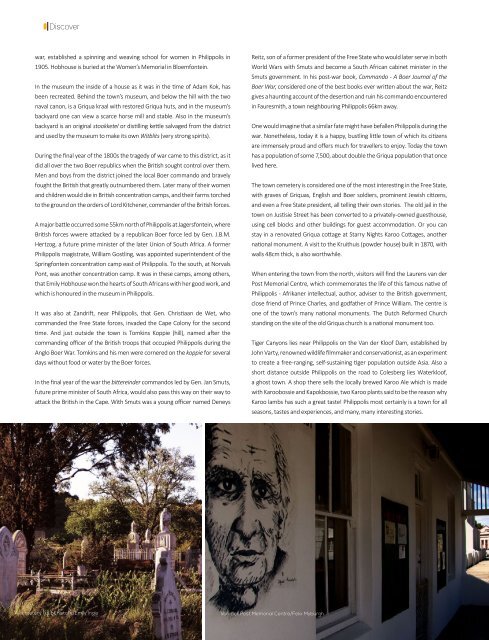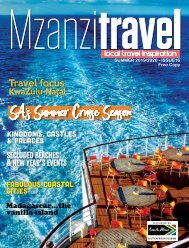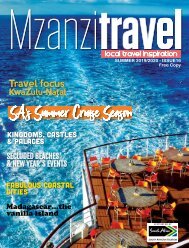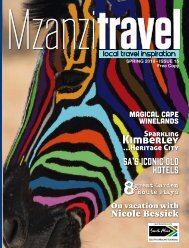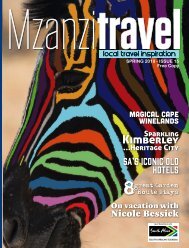Mzanzi Travel - Local Travel Inspiration (Issue 5)
MZANZI TRAVEL is a full-colour quarterly, A4 publication that sets out to showcase, foster and promote whatever South Africa has to offer to both local and international tourists.
MZANZI TRAVEL is a full-colour quarterly, A4 publication that sets out to showcase, foster and promote whatever South Africa has to offer to both local and international tourists.
You also want an ePaper? Increase the reach of your titles
YUMPU automatically turns print PDFs into web optimized ePapers that Google loves.
Discover<br />
war, established a spinning and weaving school for women in Philippolis in<br />
1905. Hobhouse is buried at the Women’s Memorial in Bloemfontein.<br />
In the museum the inside of a house as it was in the time of Adam Kok, has<br />
been recreated. Behind the town’s museum, and below the hill with the two<br />
naval canon, is a Griqua kraal with restored Griqua huts, and in the museum’s<br />
backyard one can view a scarce horse mill and stable. Also in the museum’s<br />
backyard is an original stookketel or distilling kettle salvaged from the district<br />
and used by the museum to make its own Witblits (very strong spirits).<br />
During the final year of the 1800s the tragedy of war came to this district, as it<br />
did all over the two Boer republics when the British sought control over them.<br />
Men and boys from the district joined the local Boer commando and bravely<br />
fought the British that greatly outnumbered them. Later many of their women<br />
and children would die in British concentration camps, and their farms torched<br />
to the ground on the orders of Lord Kitchener, commander of the British forces.<br />
A major battle occurred some 55km north of Philippolis at Jagersfontein, where<br />
British forces wwere attacked by a republican Boer force led by Gen. J.B.M.<br />
Hertzog, a future prime minister of the later Union of South Africa. A former<br />
Philippolis magistrate, William Gostling, was appointed superintendent of the<br />
Springfontein concentration camp east of Philippolis. To the south, at Norvals<br />
Pont, was another concentration camp. It was in these camps, among others,<br />
that Emily Hobhouse won the hearts of South Africans with her good work, and<br />
which is honoured in the museum in Philippolis.<br />
It was also at Zandrift, near Philippolis, that Gen. Christiaan de Wet, who<br />
commanded the Free State forces, invaded the Cape Colony for the second<br />
time. And just outside the town is Tomkins Koppie (hill), named after the<br />
commanding officer of the British troops that occupied Philippolis during the<br />
Anglo Boer War. Tomkins and his men were cornered on the koppie for several<br />
days without food or water by the Boer forces.<br />
In the final year of the war the bittereinder commandos led by Gen. Jan Smuts,<br />
future prime minister of South Africa, would also pass this way on their way to<br />
attack the British in the Cape. With Smuts was a young officer named Deneys<br />
Reitz, son of a former president of the Free State who would later serve in both<br />
World Wars with Smuts and become a South African cabinet minister in the<br />
Smuts government. In his post-war book, Commando - A Boer Journal of the<br />
Boer War, considered one of the best books ever written about the war, Reitz<br />
gives a haunting account of the desertion and ruin his commando encountered<br />
in Fauresmith, a town neighbouring Philippolis 66km away.<br />
One would imagine that a similar fate might have befallen Philippolis during the<br />
war. Nonetheless, today it is a happy, bustling little town of which its citizens<br />
are immensely proud and offers much for travellers to enjoy. Today the town<br />
has a population of some 7,500, about double the Griqua population that once<br />
lived here.<br />
The town cemetery is considered one of the most interesting in the Free State,<br />
with graves of Griquas, English and Boer soldiers, prominent Jewish citizens,<br />
and even a Free State president, all telling their own stories. The old jail in the<br />
town on Justisie Street has been converted to a privately-owned guesthouse,<br />
using cell blocks and other buildings for guest accommodation. Or you can<br />
stay in a renovated Griqua cottage at Starry Nights Karoo Cottages, another<br />
national monument. A visit to the Kruithuis (powder house) built in 1870, with<br />
walls 48cm thick, is also worthwhile.<br />
When entering the town from the north, visitors will find the Laurens van der<br />
Post Memorial Centre, which commemorates the life of this famous native of<br />
Philippolis - Afrikaner intellectual, author, adviser to the British government,<br />
close friend of Prince Charles, and godfather of Prince William. The centre is<br />
one of the town’s many national monuments. The Dutch Reformed Church<br />
standing on the site of the old Griqua church is a national monument too.<br />
Tiger Canyons lies near Philippolis on the Van der Kloof Dam, established by<br />
John Varty, renowned wildlife filmmaker and conservationist, as an experiment<br />
to create a free-ranging, self-sustaining tiger population outside Asia. Also a<br />
short distance outside Philippolis on the road to Colesberg lies Waterkloof,<br />
a ghost town. A shop there sells the locally brewed Karoo Ale which is made<br />
with Karoobossie and Kapokbossie, two Karoo plants said to be the reason why<br />
Karoo lambs has such a great taste! Philippolis most certainly is a town for all<br />
seasons, tastes and experiences, and many, many interesting stories.<br />
A cemetery full of history/Emily Ingle<br />
Van der Post Memorial Centre/Felix Myburgh


